Food Industry's Automation Advancements!
The food industry is witnessing a significant transformation as automation technology takes center stage. This shift is improving efficiency, quality, safety, and operational efficiency across various sectors, including logistics, transportation, aerospace manufacturing, and, most notably, the food industry itself.
Meeting Quality and Safety Standards
Automation is reducing human contact with food, thereby lowering contamination risks and improving hygiene. Advanced cleaning and real-time environmental monitoring ensure compliance with stringent food safety regulations, fostering trust and minimizing foodborne illness risks. Digital traceability platforms, integrating IoT sensors and blockchain, enhance HACCP compliance and expedite recall responses, aligning with FDA mandates effective from 2026.
Improving Loading and Unloading Operations
Strategic partnerships between industry leaders are developing holistic automation solutions for the End-of-Line area, including labeling, inspection, stacking, and palletizing. These systems, combining robotics, vacuum gripping, and slicing technologies, handle delicate food products hygienically and efficiently, addressing labor shortages and increasing automation adoption.
Enabling 24/7 Production
Automation systems, equipped with advanced sensors and AI, manage repetitive tasks faster and with consistent precision than human labor. This allows food processing facilities to scale production continuously without compromising quality or safety, supporting the meeting of rising consumer demand and maintaining a reliable supply chain.
Boosting Efficiency in Picking and Packing
AI-guided robots can adapt gripper force and placement paths dynamically, such as in ready-to-eat meal lines. This flexibility drives significant waste reduction and short payback periods, leading to higher throughput.
Market Growth and Outlook
The food processing automation market was valued at USD 27.95 billion in 2025 and is expected to grow at a compound annual growth rate (CAGR) of 7.4%, reaching over USD 40 billion by 2030. Emerging trends include more sophisticated, wash-down-ready robots for hygienic environments, AI-enhanced robotic kitchens and service bots, and integration of predictive analytics for improved supply chain and customer service management.
In conclusion, automation in the food industry is evolving toward modular, fully automated, hygienic, and contact-free processes that enhance quality control, safety compliance, operational speeds, and labor efficiency. Key Technology, a leading food processing equipment manufacturer, offers high-performance digital sorting, conveying, and process automation solutions. As the industry continues to grow and refine, automation will likely become a more compelling solution for tracking down batches of items after a product recall, identifying bottlenecks in processing or packaging departments, and boosting efficiency and food safety throughout the foodservice value chain.
- The shift towards automation in global trade sectors, such as logistics, transportation, and the food industry itself, is expected to continue, with the food processing automation market projected to reach over USD 40 billion by 2030.
- As part of this growth, technology advancements are focusing on creating more hygienic and contact-free automation systems, particularly in the food industry, to ensure compliance with stringent food safety regulations.
- In the food-and-drink sector, automation is revolutionizing various aspects of the supply chain, from reducing human contact with food and lowering contamination risks, to improving loading and unloading operations and enabling 24/7 production for increased efficiency.
- To address labor shortages and comply with evolving industry standards, strategic partnerships between industry leaders are developing holistic automation solutions encompassing advanced technologies like robots, AI, and IoT, which can adapt to the specific demands of a variety of sectors, including finance, lifestyle, and aerospace manufacturing, in addition to food and drink.




